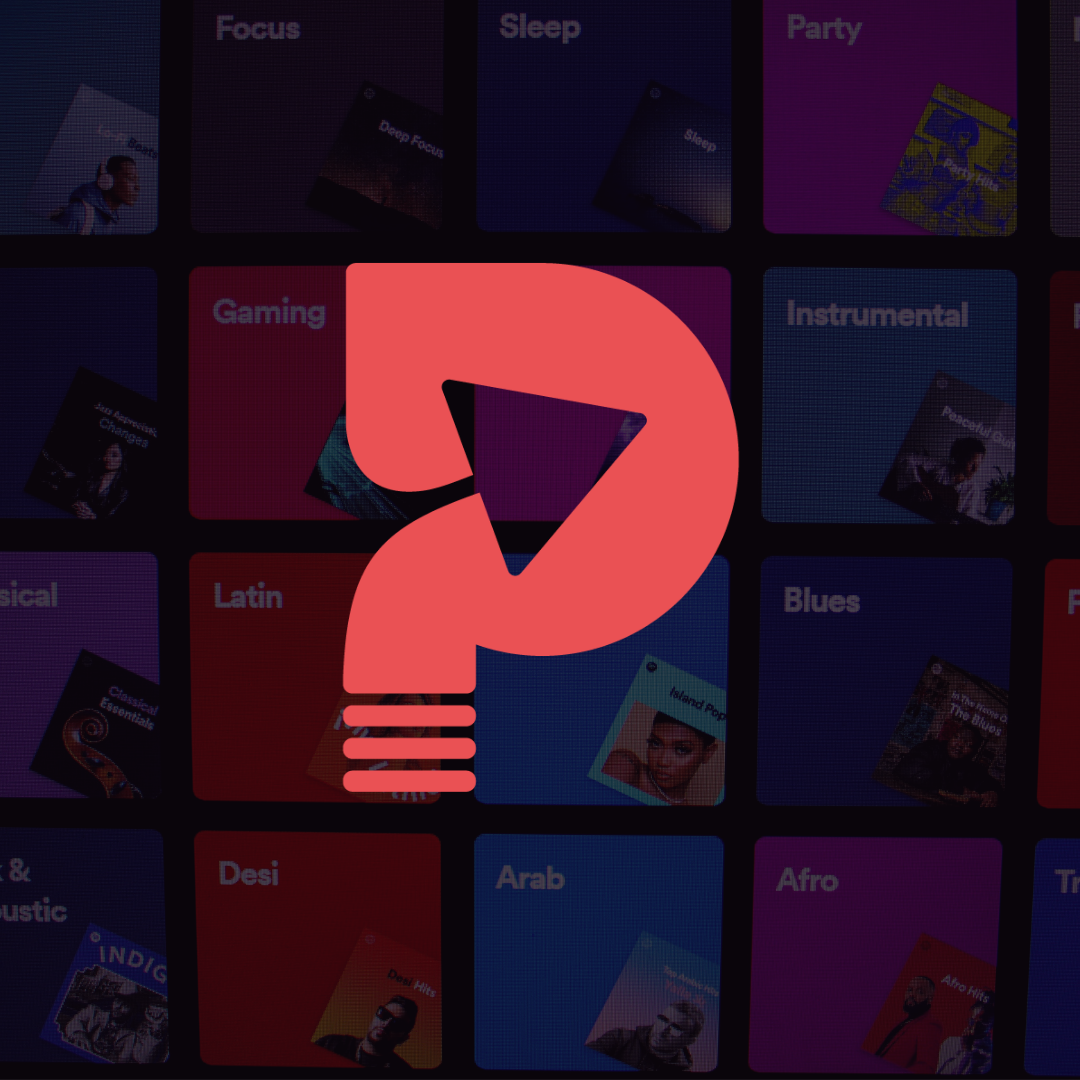So you’re thinking about trying Playlist Push, eh?
I’ve been there, and it’s kind of a scary place.
Basically, you’re considering spending a significant amount of money on a song you care a lot about – while dealing with the gnawing doubt that you may be throwing it down the drain and the confusion of sorting through a weird mix of Trust Pilot reviews.
Here’s the reality: for Playlist Push to be worth it, there are really two questions that need to be answered.
- Does Playlist Push have a strong network to pitch to (meaning, playlists that are not infested with bots)?
- Will my song work?
Despite what you may have heard, the answers aren’t straightforward.
Look, there’s a ton of advice out there to “avoid playlist pitching services” flat out, hard-stop.
This Venture article, for example, makes a frighteningly compelling argument that boils down to this: Third-party playlists are heavily populated by bots. Paying to get pitched to bot-infested playlists is actively harmful.
It’s a good argument, and there’s absolutely truth to it. But it all rests on that first premise that third-party playlists are populated by bots. From what I’ve seen, that’s not a false premise, but it’s also not entirely true.
And despite the many articles online encouraging you to stay away from them, playlist pitching services have thrived over the last couple of years; in 2023, these tools play a crucial role in the career of artists big and small, who can find plenty of music promotion services available, each with their own formula for success.
But I’m getting bogged down before I’ve begun. Let’s cut to the chase, and then I’ll circle back with details. Here’s the answer you’re looking for…
Is Playlist Push worth it? As of right now, assuming that you have a strong song, my conditional answer is yes.
If you want to try a campaign yourself, use the code CXUFDQ2 and you’ll get 7.5% off.
Disclosure: That’s an affiliate link, but, as you’ll see from this review, it’s not an unconditional endorsement of Playlist Push.
There’s nuance here, but my conditional “yes” is based on the following rationale:
At the end of 2021, I ran a $325, one-month campaign for the song “Hopeful” by Thomas Austin (who happens to be my brother), and by the conclusion of the campaign, we’d tallied 13 new playlist adds and around 40,000 new streams for the track.
(Editor’s note: I recently ran another campaign in early 2023 and made a video about it. I’ll be updating this post with the details shortly, but for now, you can check out the video version of my most recent campaign here.)
(Okay back to the written stuff.)
Here are the results from my Playlist Push campaign as shown in their backend dashboard:
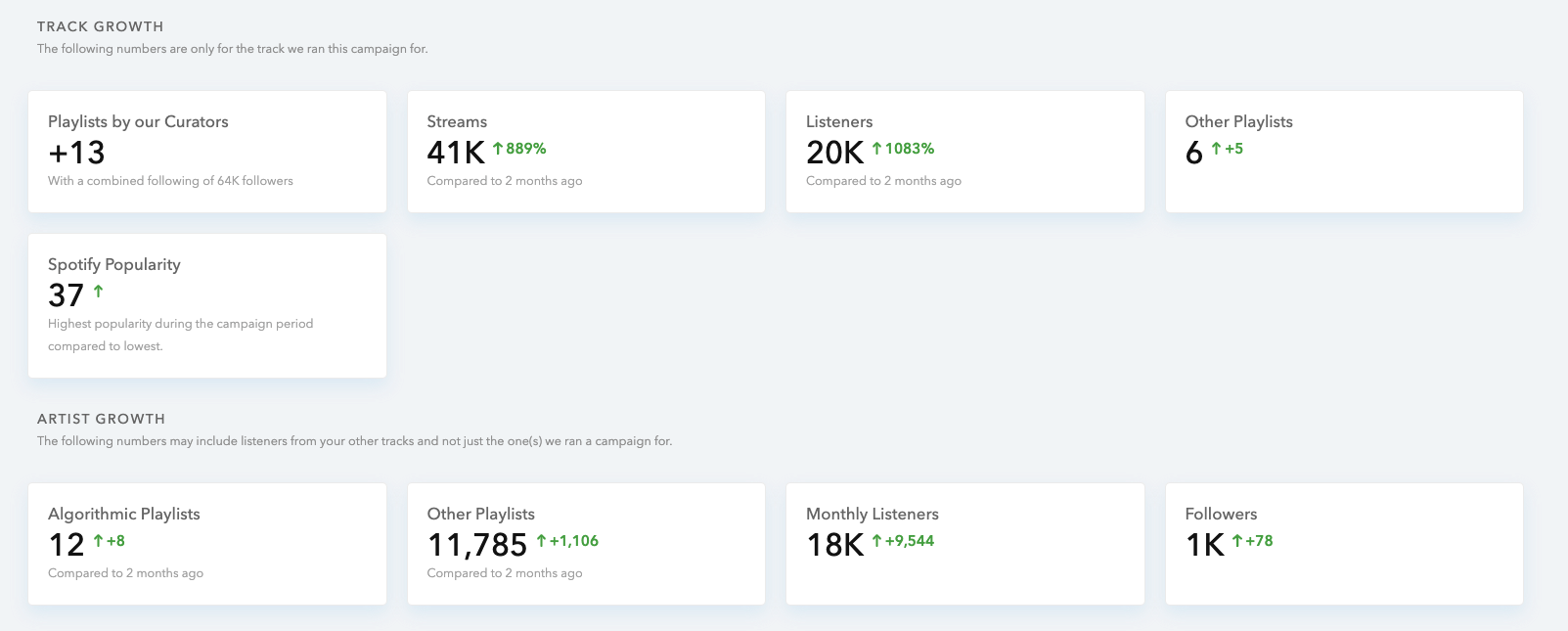
(Note: To let the platform pull this data, I had to give Playlist Push “Reader” access to Tom’s Spotify for Artists profile.)
Looks good, right? I mean, I thought it did. But I want to get past first impressions, so I’m going to run through what the process was like step-by-step and break down what those numbers looked like in our Spotify for Artists profile (and what they actually meant over the longer-term).
Over the course of this article, I’ll also be keeping in mind the first question that I noted will impact the the viability of Playlist Push – do they have a strong network (without bots)? Because if those streams aren’t legitimate, they’re harmful, not helpful.
With all of that said, let’s dive in.
What’s it like to submit a song to Playlist Push?
First off, Playlist Push is very intuitive to use.
I’ve used and reviewed many Spotify promotion services over the past few years, and based on my experience there are usually two kinds: the automated but buggy platforms that feel like they were designed by a 13-year-old, and the manual services that rely on Google spreadsheets and personal back-and-forth email communication.
Playlist Push is neither.
It’s automated, yeah, but it’s impressively clean. You feel like you’re using something that was made in Silicon Valley, not whipped up with broken code and duct tape in a basement somewhere.

Here’s what it looks like to submit a song:
As you can see, they’ve recently added the ability to submit to Tik Tok curators. Since Tom wasn’t concerned about that, we stuck with Spotify.
Below those first two options, you’ll get fields to upload the song and meta data.
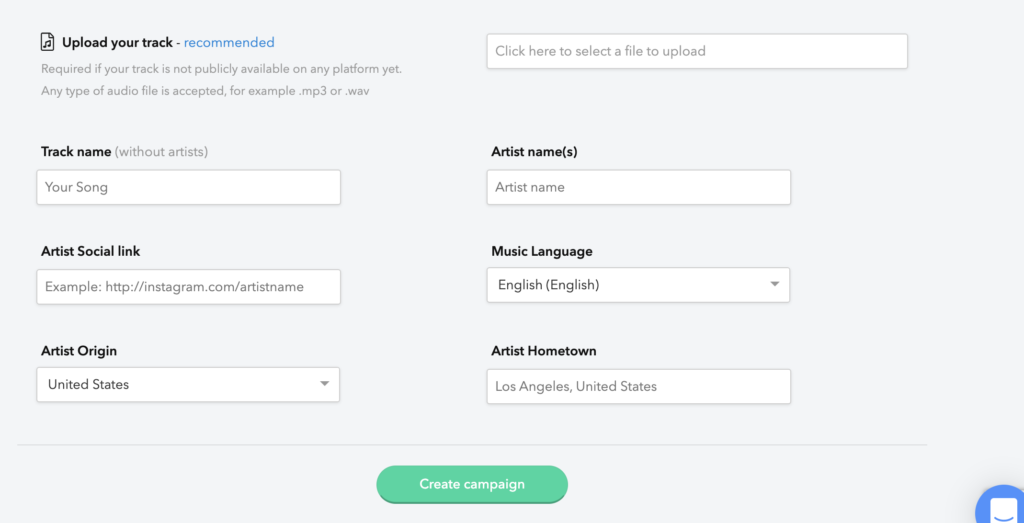
Pretty straightforward stuff, and filling it all out isn’t terribly complex. But things start to get pretty cool pretty quickly when you hit the green button.
One of the keys to running an effective pitching campaign of any kind (press, influencer, radio, etc.) is to target the right people – the ones who will resonate most with your music.
Playlist Push makes doing this pretty dang easy.
The platform pulls from Spotify’s API to grab a bunch of important data on your music, allowing you to place yourself in context very effectively.
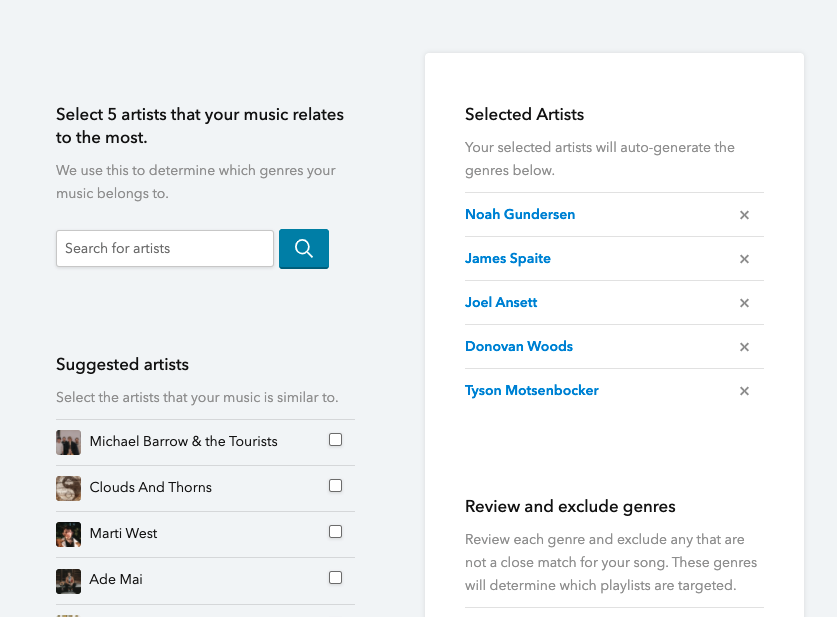
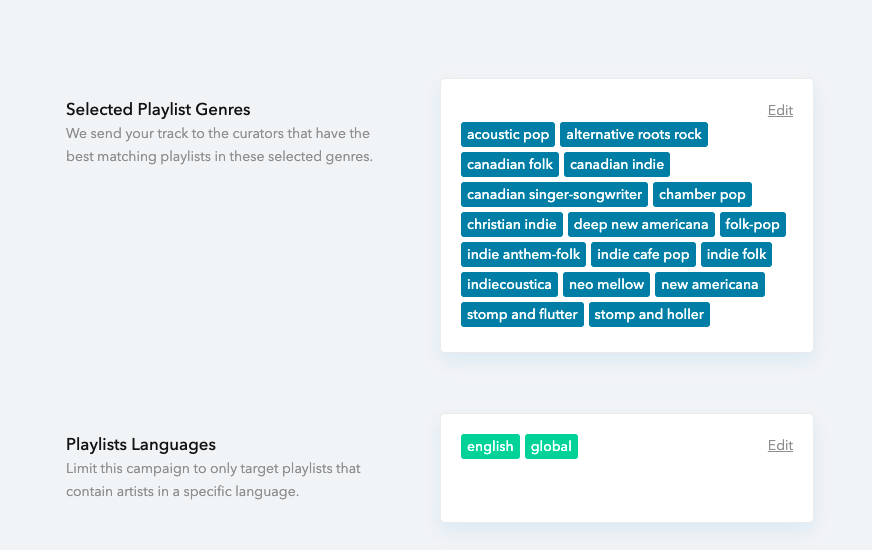
You know the “Fans Also Like” section on your Spotify profile? Playlist Push pulls that in under a “Suggested artists” section. You can check any artist that appears, or search for artists that don’t. Based on the artists you choose, Playlist Push will automatically tag your track with similar genres.
Again, this stuff is very important.
You’ll see that Playlist Push notes that “We send your track to the curators that have the best matching playlists in these selected genres.” In other words, those tags determine who you’re pitched to, and who you’re pitched to determines where (and if) you’re placed.
Full disclosure: I didn’t do a great job of paring these tags down when I ran our campaign. I decided to roll with the default tags the platform pulled based on the artists I selected – but if I went back and ran this campaign again, I’d get rid of the “Canadian” tags. Those appeared because I noted Donovan Woods as a similar artist; he is a similar artist, but Tom’s not Canadian. Thankfully, this only had a minor impact (a few rejections), but it easily could’ve been worse.
Whoops.
Anyway, you wrap up by setting a budget and a date for the campaign to launch:
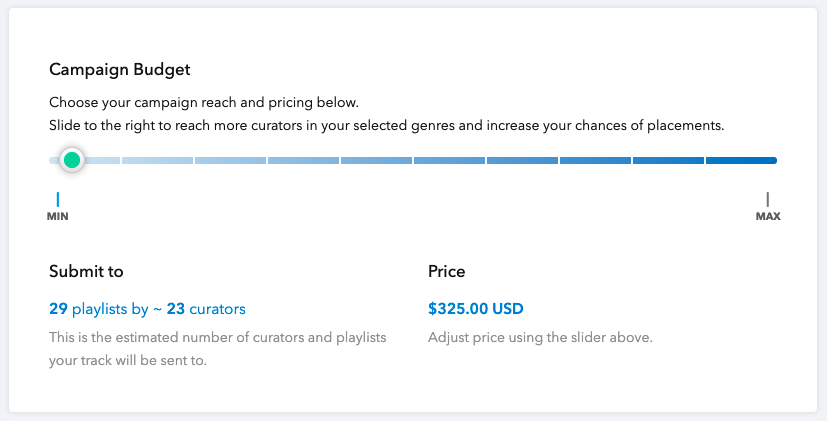

As you can see, $325 is way on the low side of the spectrum, and it meant that our song was only pitched to around 23 curators. We were just testing the platform, so that was all we wanted, but you can spend a lot more and (ostensibly) get in front of more curators.
Finally, we submitted payment and were notified that the song and campaign were approved.
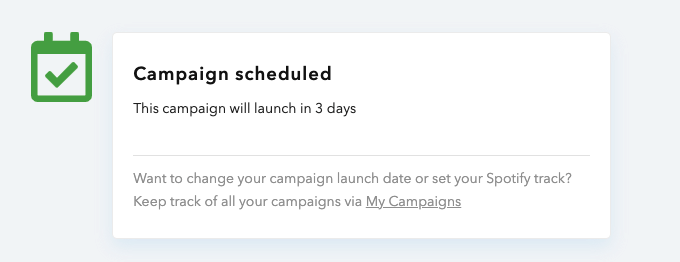
From there, it was a waiting game to watch the results come in. And that leads me to the somewhat controversial side of Playlist Push:
How does Playlist Push actually work?
On the artist side, you literally don’t do anything except upload and tag your track. On the Playlist Push side, it’s rather unclear what happens. Here’s what they say:
When you run a campaign your song will be sent to a targeted group of playlist curators. Each curator has a playlist with an active following. During your two week campaign, curators will review your song, and if they like it they have the option to add it to their playlist. When this happens we send you an email instantly with a link to that playlist.
That’s taken directly from Playlist Push’s FAQ page. I think it’s a little confusing, personally. But behind the curtains, what’s actually happening is this:
Playlist Push is showing your track to playlist curators and paying them a set amount of money to review the track.
The amount curators are paid is dependent on the size of their audience. Importantly, curators earn through reviews; they are not paid to place tracks. This model falls within the gray-area bounds of Spotify’s terms, which specify that paid placements are not allowed. It’s the same general model that SubmitHub uses, and yes, it is legal.
The method that Playlist Push uses to select curators for pitches is also unclear. It’s obvious that the platform uses the data you submit to determine where you’re pitched; it’s not obvious exactly how. For now, the system is kind of a black box.
(Semi-relevant side note: On the curator side, to get on Playlist Push and be eligible to review tracks, you need at least 1,000 Spotify followers; I actually tried to add my own Spotify playlist and didn’t meet the follower threshold. You also need to pass a screening process. This is the key to Playlist Push keeping their playlists active and clean – more on it later.)
But that’s basically it. Your song gets sent to curators, they give you feedback, and you get emails telling you if you got placed.
All told, for our campaign, this process took a month.
What were the results of the Playlist Push campaign like?
Here’s where the rubber meets the road.
As you’ve already heard, I have a pretty favorable perspective on the results from the campaign. Based on the reviews we can see in the backend, “Hopeful” was pitched to 22 curators; nine of these people rejected the song.
You get to see everyone’s feedback, and most of the people who didn’t place the track were at least kind about it.
(For example: “This is a really sweet track! I love how calming your guitar style is and you both have great voices! The storytelling in your lyrics is really sweet, too. I felt like the melody didn’t catch my attention enough, though. Thanks for submitting!”)
13 people did place the song, though. Here’s the table with their playlists and feedback:
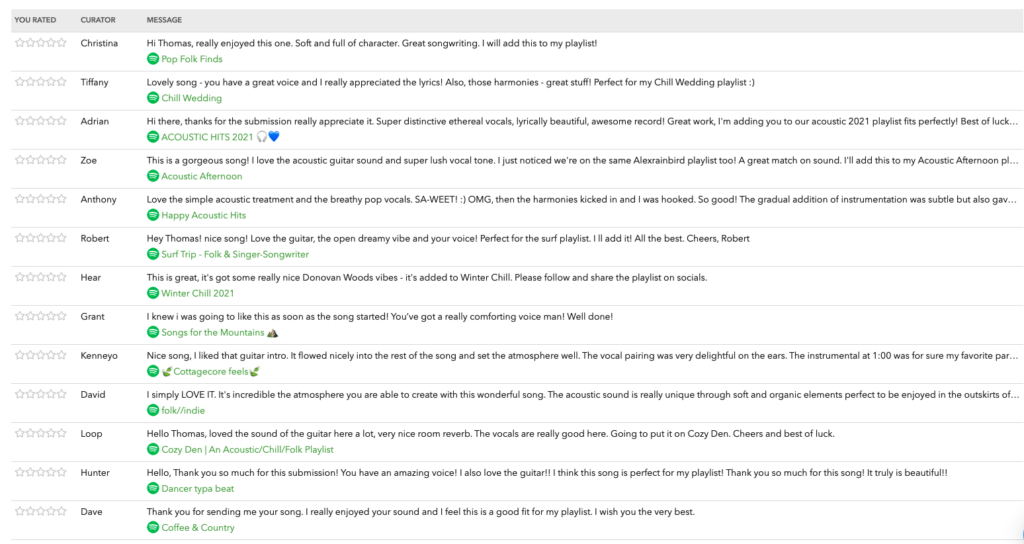
For those of you keeping track at home, that’s a 59% placement rate, which, based on my experience, is quite good.
This is where the second question as to Playlist Push’s viability comes into play – “Will it work for my song?”. I’m biased, but I think “Hopeful” was a very strong track. If it had sucked, I’m nearly positive we wouldn’t have gotten 13 placements for $325.
The strength of the song impacts your ability to get results on Playlist Push – or anywhere else.
You’ll note that a couple of these placements are pretty weird. Listen to “Hopeful” for five seconds and you’ll hear that it’s absolutely not a “Dancer typa beat.” It’s also probably not a “Happy Acoustic Hit” (although if you ignore the lyrics I guess I could see it).
But the vast majority – I’d say 11 out of 13 – of these placements are actually spot on.
There are no weird movie soundtracks, foreign-language lists, or wack-genre adds; at least at face value, this is a pretty good list of playlist placements.
And that showed as the streams came in.
Here are a few charts from the Spotify for Artists side.
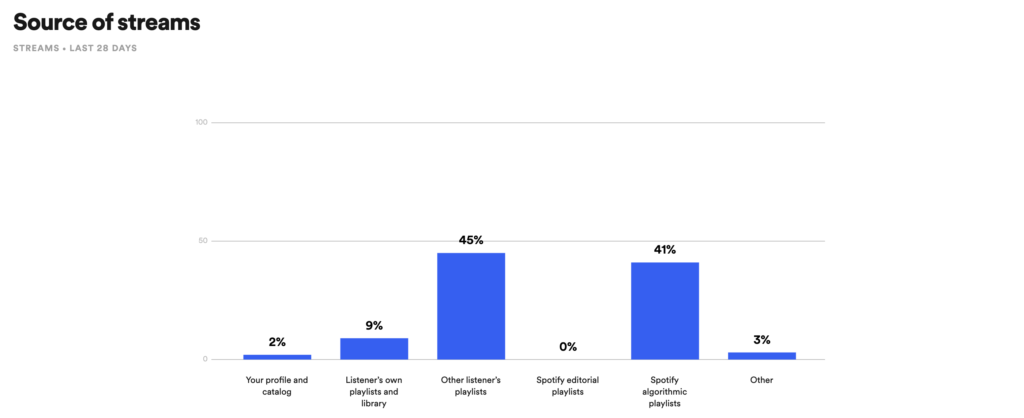
Note that Spotify is pretty tight-fisted with data, and they don’t let you set custom date ranges for many of their charts, which means this data isn’t from the time period where the campaign was active.
But that arguably makes this even more impressive.
As you can see, over the last 28 days (which is December 21, 2021 – January 18, 2022), the largest chunk of streams for “Hopeful” have come from “Other listener’s playlists” – in other words, third-party, curated playlists like the ones Playlist Push pitches to.
The takeaway: The campaign wrapped up about a month ago, and it’s still getting results.
Importantly, the second-biggest chunk of streams is from “Spotify’s algorithmic playlists”. These are mood-based playlists or user-specific lists like Discover Weekly, and we’ve consistently been getting more plays here over time. The fact that we’re still getting consistent traction from Spotify’ algorithm shows that Playlist Push’s campaign didn’t derail our chances of organic growth.
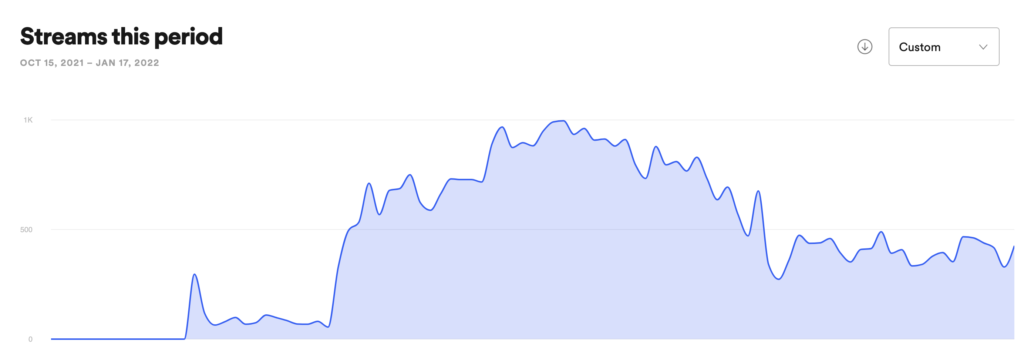
👆 This chart does let you select specific dates, and, accordingly, it gives you a better picture of the streaming bump from the campaign.
Note where the new level is when the campaign finishes (that dip toward the final third) – significantly higher than it was on November 1, when the song had been out for a week with hardly any plays. As I write this, “Hopeful” is averaging 300-400 plays per day; for the first couple of weeks after release, it was at ~100.
Okay, last chart…
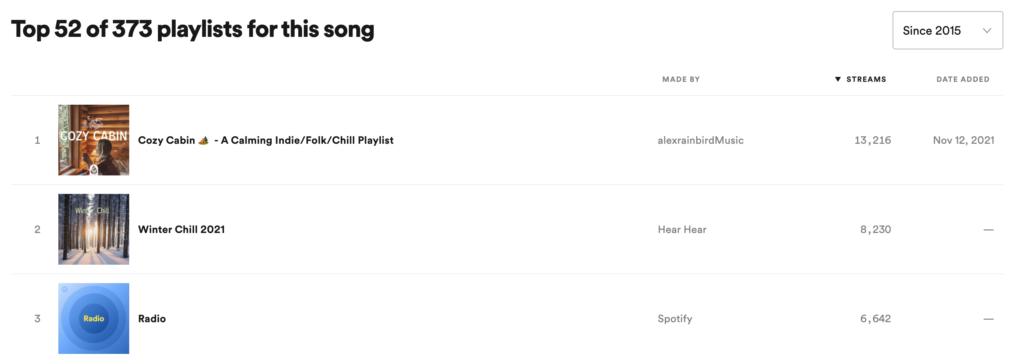
Again, Spotify doesn’t let you filter by a specific date, so I just went all the way back to show all of the song’s streams. And you can see that out of all 373 playlists, two third-party playlists top the list in terms of streams, with Spotify’s useful “Radio” following in third.
Important note here in the interest of clarity: While that top playlist (Cozy Cabin) is from a third-party curator, it is not a Playlist Push placement and so is not attributable to the campaign I’m reviewing. Winter Chill 2021, however, absolutely is.
As you can see, those two placements have driven over 20,000 plays in a few months – while the song’s algorithmic reach has continually improved.
Final review of the numbers our Playlist Push campaign
Here’s where the song sits today:

And again, that started from basically scratch before our campaign.
If you crunch the numbers, as of January 2022 we paid:
- $25 per playlist placement
- $0.008 per stream (although this will probably go down a bit more, it’ll likely never break even with the payout we’ll get from Spotify)
All told, that’s not bad. And as I’ve highlighted a few times, it’s all happened while the song’s algorithmic reach has improved.
That’s awesome.
And it’s a refutation of the claim that all third-party playlists are populated primarily by bots.
The truth (at least, according to what I’ve seen) is that many third-party playlists are populated by bots – but not all of them are. Based on the engagement data we’re seeing, the third-party playlists we ended up on are being listened to by real users.
The challenge, for Playlist Push and for services like it, is to continually screen against bots and bad curators so that the playlists continue to be high quality. And that leads me to my final caveat:
The effectiveness of Playlist Push will vary at any given point in time.
Different artists will certainly get different results, because, again, the strength of the music is critically important. But, weirdly enough, the same artist submitting a similar track a year apart will almost certainly see variance in results, too – because the world of third-party playlists is constantly in flux.
For proof, check out these two reviews by the same artist published one year apart:
To quote the author of both, Brian Hazard (whose blog you absolutely should follow if you’re interested in DIY music promotion):
When I first reviewed the service in November, they were experiencing a massive influx of curators, and weren’t able to screen them all properly. As a result, my five playlist adds were of negligible to questionable value, and I didn’t see my Spotify numbers budge.
TL;DR – Brian’s second review, written a year after his first, is much more favorable than the original.
Ari Herstand had kind of the reverse experience. He initially recommended the service before settling against Playlist Push most recently.
The bottom line is this: People are making, changing, and forgetting about their playlists all the time. New curators pop up. Old ones leave the game. It’s an endless cycle.
That means that running a campaign is always a risk.
Playlist Push’s ability to deliver depends on their roster of curators, and their roster of curators has more turnover than the coaching staff of the Jacksonville Jaguars.
With that said, robust screening systems do help. And from my perspective, Playlist Push has done an admirable job of building those.
I think the service has improved over time – and, as of January 2022, I feel comfortable recommending it (with the caveats noted above) as a worthwhile investment for driving a foundation of Spotify streams.
I’ll end with a quick breakdown of what I see as the service’s benefits and drawbacks.
The pros of Playlist Push
- Intuitive interface / easy to use. It’s really user-friendly.
- Good job of placing your music in context using Spotify’s data. This makes it easier for them to pitch you to the right people.
- The number of curators on the platform is impressive. (They claim to have over 970, which is very good.)
- Decent reporting (but you do have to give them access to your Spotify for Artists profile).
The cons of Playlist Push
- No guaranteed results. I actually don’t think this is a con, because services promising a guaranteed number of streams are often (not always) scams – but it still might make you hesitate before you push the buy button.
- Not hands-on – you don’t have control over who you’re pitched to, and unlike when you work with a boutique agency, you don’t get the benefit of relationships building over time.
- You don’t get curator contact info, so you have no way to retarget curators. This is probably the biggest drawback to using the service.
- I’m a little doubtful that the data they offer in your final report is totally accurate. They basically compare your streams from during and after your campaign to your streams before the campaign – but I don’t think they parse enough of the data for the numbers to be totally accurate.
And with all of those factors considered, here’s the final verdict one more time:
If you want to boost your Spotify metrics, Playlist Push can be a worthwhile investment.
Given the minimal payout per stream that Spotify offers, you’re almost certainly not going to make money back on a campaign, and given the ever-changing nature of the curator field, your results are always something of a risk.
But if you want to establish a foundation of streams that benefit further algorithmic growth, the platform can work – assuming your song is strong.
It worked for me.
If you want to try a campaign yourself, use the code CXUFDQ2 and you’ll get 7.5% off.
(And, again, that’s an affiliate link.)
All right, one last thing that is probably more important than anything else I’ve written over the course of this review: Please remember that the value of your music isn’t reflected in the number of your streams.
Streams are fun, but music matters more. It’s an end in itself.
And on that note: Keep making beautiful things, and good luck.
Editor’s note: After I wrote this review, George (the founder of Playlist Push) reached out to me. We had an enjoyable chat and I wrote another piece about Playlist Push based on that interview. The article is mostly about George’s background, but it includes a little more detail on how Playlist Push works behind the scenes. And that’s that. Thanks for reading.

